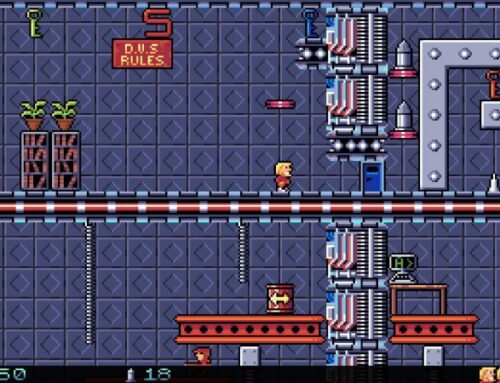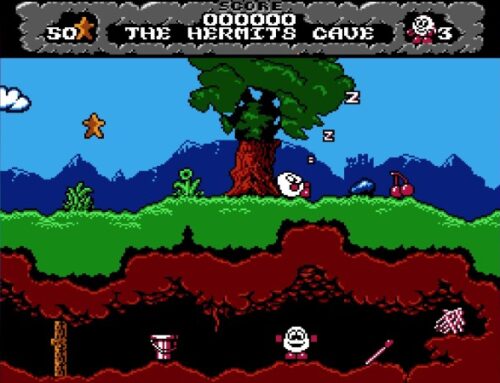Astrosmash is a beloved favourite of Intellivision fans everywhere. Designed by John Sohl and first released in 1981 — with an Atari 2600 port known as Astroblast following in 1982 — it went on to be one of the most popular games of the ’80s, selling nearly a million copies by mid-1983, and over two million copies in total by 1999, according to the Edmonton Journal.
Now, the game has made a grand return — this time to the Evercade, as part of the Intellivision Collection 1 cartridge, number 21 in the Evercade’s “red” library of console releases. (If you’re unfamiliar, the Evercade’s new arcade lineup comes in a separately numbered library of purple cases.)

Astrosmash is a pretty simple game at heart; the game doesn’t even make much of an effort with any sort of narrative setup in the manual — it simply informs you that “Chicken Little was right” and that the sky is, in fact, falling. It’s up to you to blast the incoming meteors and alien forces and survive for as long as possible while racking up as many points as you possibly can.
The game unfolds as a fixed shooter, in which you can move a laser cannon left and right at the bottom of the screen, and fire shots either by pressing a fire button or by activating the three-shot-per-second autofire mode. The latter was included at least partly because the fire buttons on the original Intellivision controller were notoriously uncomfortable to press, since they were on the side of the device — but it’s still a welcome inclusion even if playing on a more comfortable modern controller.
Initially, your foes are nothing more than falling rocks, and failing to shoot them before they hit the planet surface simply costs you a few points. But before long, you start to see spinning bombs, which emit a piercing screech as they descend to the ground — these will cost you a life if they make contact with the planet surface.
After that, you’ll encounter guided missiles that will track your laser cannon and, in some cases, follow it along the ground — in these instances, you’ll need to quickly hit the “hyperspace” button to dodge to a random location in the hope you can avoid the danger.
And finally, you’ll start encountering UFOs, which fire large shots directly at your laser cannon — though thankfully these don’t home in once they’ve been fired.

As you blast your way through your enemies you will, of course, score points — though note that as you continue to play, missed asteroids will continue to cost you points as well. And this brings in one of Astrosmash’s most distinctive mechanics: the concept of “peak score”.
Peak score is a pretty simple idea: things happen in the game based on the highest point your score has been, even if it has subsequently dropped past that point due to falling rocks. The main function of this is to award you an extra life at a very generous interval of 1,000 points, but the game speed also increases as your peak score rises.
On top of that, when your current score reaches particular intervals, the screen’s colour palette changes and the score multiplier increases, up to a maximum of 6x the usual number of points once you cross the 100,000 point boundary.
Astrosmash is quite notorious for individual games lasting a very long time — primarily due to that exceedingly generous extra life interval, which is very easy to reach within a target or two once you’ve built your multiplier up a bit. It’s not uncommon to spend significant amounts of time with 20 or more lives in stock — though as the game speed increases you will eventually reach a point where you are losing lives faster than gaining them.
It takes a while to get there, though; when sitting down for a game of Astrosmash, you’ll want to set aside at least half an hour or more to play a full game through to completion — even more once you get skilled enough to reach the upper tiers of the score multiplier. Because it just keeps going, and going, and going.

Part of the reason that Astrosmash has been designed in this way is that it’s not an arcade conversion; it’s a game that was specifically designed for the home. And that means there’s no pressure on it to ensure that there’s a good balance between “satisfying playtime” and “profitability”. To put it another way, most arcade games are designed in such a way that their difficulty escalates relatively quickly, and this encourages either the current player to put more coins in, or for them to give up and allow someone else to play.
Because no-one’s pumping coins into Astrosmash, it doesn’t need to do that. So it can afford to provide a much more gradual difficulty curve, which means that the pacing of the game is actually rather gentle; the opening stages might seem a little slow and boring, particularly if you’re good at banging out some really high scores, but one gets the distinct impression that this gradual, almost languid ramping up of difficulty is entirely deliberate. It allows Astrosmash to shine as the sort of game that you can only play in the home — or indeed on a handheld.
Somehow, it doesn’t become boring, however. This is mostly down to the fact that the game’s inherent simplicity makes it an excellent game to just switch off your brain and zone out to, allowing you to reach that elusive state of hyperfocused “flow” very easily indeed. Stick on a podcast or music and just let the game take you wherever it goes — big numbers make happy brains.

In fact, Astrosmash has been cited by some psychologists as one of the first games where it was really possible to reach this “flow” state for a noticeable majority of players. The use of “flow” in modern gaming has come in for some criticism from these quarters, because it’s a means through which players can be exploited and extorted through systems such as microtransactions — though Astrosmash itself is not to blame here, since it’s just a game you’ll find yourself staring at for hours at a time.
It is perhaps worth noting, however, that if your attention span is as bad as many other people’s is in 2021, there’s no need to play through an entire Astrosmash game in a single sitting if you don’t think you’re up for it or don’t have the time to do so. Instead, reach a suitable break point, save your position using the Evercade’s built-in save facility, and come back later. In that way, your attempts to reach the most epic of high scores can be split across several sessions!
In fact, with the excellent “Quick Save” function found in the system software for both the Evercade VS and the Evercade handheld 2.0 update, this is easier than ever to do; there’s even a convenient “Last Save” function on the Evercade menu to get you right back into the action without having to dig through further settings.
Of course, the real pros sit and play through an entire game of Astrosmash in a single sitting. Even if it causes their significant other to start asking “does this game ever end?” with increasing frequency and concern the longer it goes on for. I speak from experience on that particular note…




